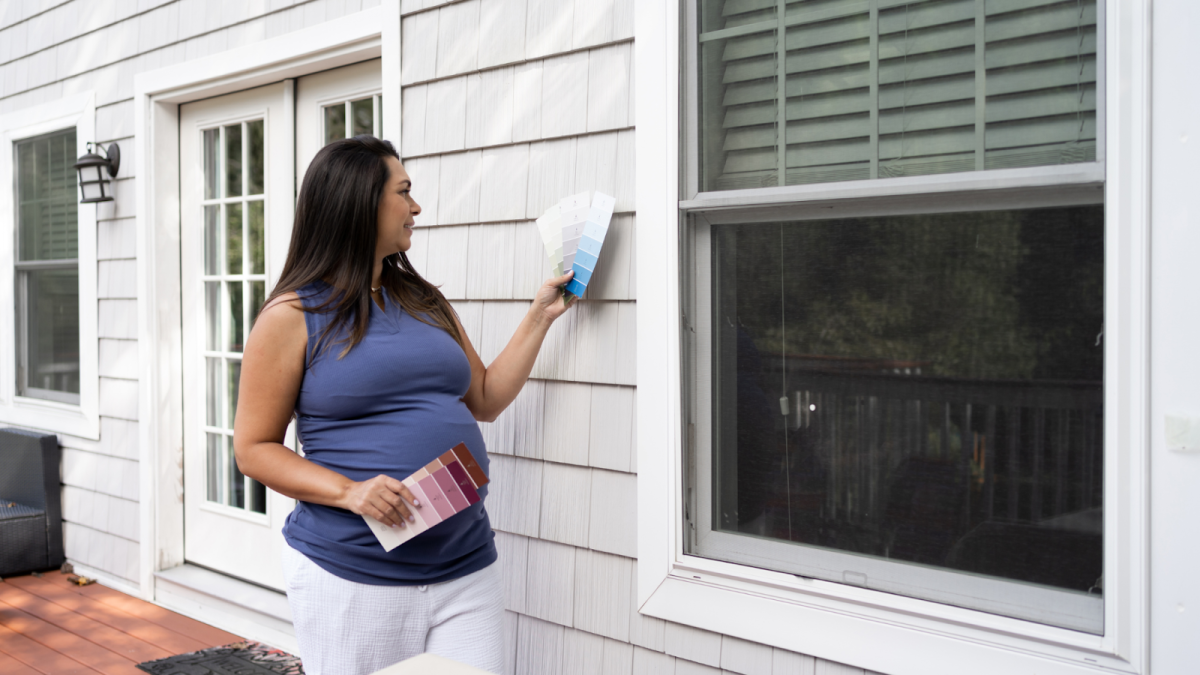- Proudly Serving the Greater Philadelphia Area
Call Bob For a Free Quote

How to Stay Protected from Lead Paint Hazards
February 1, 2023
Interior Painting Trends to Brighten Up Your Winter Day
October 27, 2023Choosing the right exterior paint colors can be daunting, but with a thoughtful approach and valuable tips, you can make an informed decision that will leave your home stunning. After all, your home’s exterior paint color is people’s first impression of your property. It sets the tone, enhances curb appeal, and reflects your style. We’re going to guide you through how to select the perfect exterior paint colors for your home.
Things to Consider When Choosing Exterior Paint Colors
Before diving into specific tips, it’s essential to consider a few general guidelines when selecting exterior paint colors:
Neighborhood Harmony: Take a look at the houses in your neighborhood. What are the other exterior home colors? While you don’t want to blend in completely, consider the overall aesthetic and ensure that your color choices complement the surrounding homes.
Architectural Style: When it comes to exterior house painting, the architectural style can inform the colors you choose (it’s hard to imagine a lilac stucco home or a garnet-red colonial house, right?). Research the recommended color schemes for your home’s architectural style to get an idea of a cohesive and visually pleasing look.
Climate and Surroundings: Your geographical location and the natural surroundings can influence the color choices for your home. Consider factors like sunlight, shade, and landscaping when selecting your exterior paint colors.
1. Outline Your Color Scheme
The first step in choosing exterior colors for your home is to outline the color scheme. The color scheme could include the primary color, which would you can use mainly on the siding, shutters, and window frames; a secondary hue for accents such as trim, doors, and other architectural features; and an accent color (often a bright color) for shutters and doors, as well as the decorative trim color.
2. Get Inspired By Your Neighborhood
One effective way to choose exterior paint colors is to take inspiration from other houses you admire. Look around your neighborhood or browse online for homes with similar architectural styles and note the color combinations that catch your eye. Take pictures or save images for reference and consider how those colors might translate to your home. Use that inspiration as a starting point to develop your own unique palette.
3. Resist Trends
While it can be tempting to follow the latest residential painting trends in exterior paint colors, it’s important to remember that trends come and go. What’s popular today may not be tomorrow. Instead, focus on selecting colors you genuinely love that will stand the test of time. Neutral hues and earth tones like beige, gray, and white are timeless choices that can create an elegant and sophisticated look. If you want to incorporate a bold color, consider using it for accents or more minor elements that you can easily update in the future.
4. Take Clues From Your Home
Your home can provide valuable cues to help you choose the right exterior paint colors. Consider the existing elements of your home, such as the roof color, brick or stone accents, and any fixed architectural details. These elements have their inherent colors and textures that should be considered when selecting paint colors. Choose hues that harmonize and enhance these existing elements rather than clash with them.
5. Get Familiar With the Color Wheel
If you need clarification on color combinations, turn to the trusty color wheel for guidance. The color wheel can help you create complementary, analogous, or monochromatic color schemes that are visually pleasing and harmonious. Complementary colors are located opposite each other on the wheel (i.e., blue and orange) and can create a vibrant and balanced look. Analogous colors are adjacent to each other (i.e., blue and purple) and can create a more harmonious and calming effect. Monochromatic color schemes involve using different shades and tints of a single color for a sophisticated and cohesive appearance.
6. Test Once, Then Test Again!
Once you have narrowed down your color choices, testing them before making a final decision is crucial. Purchase sample pots of the paint colors you’re considering and apply them to a small, inconspicuous area of your home’s exterior. Observe how the colors look in different lighting conditions and times of the day. Remember that colors can appear different in natural and artificial light, so seeing them in various settings is essential. Additionally, consider how the colors interact with the other elements of your home, such as the roof, trim, and doors. You can ensure you’re making an informed decision by testing the colors.
7. Be Open to New Ideas
Once you’ve narrowed down a color palette and tested it out, don’t be afraid to maintain some flexibility! If, after testing the colors, you don’t feel like they are quite suitable for your home, it’s completely okay to try something different. You may find that a completely unexpected combination of colors is exactly what you needed all along. The opinions of friends and family can also give you a fresh perspective.
In conclusion, choosing exterior home colors requires careful consideration. By following these tips, you can simplify the process and make confident decisions to enhance your home’s overall look and appeal. Remember to take cues from your home’s existing elements, avoid getting caught up in trends, and, most importantly, test your chosen colors before committing.
With a thoughtful approach, you can transform your home’s exterior into a beautiful, welcoming space that reflects your style. We proudly provide both exterior and interior painting services to bring your vision to life! If you need house painters in Pennsylvania, we’re ready to take your call! Learn more here!

